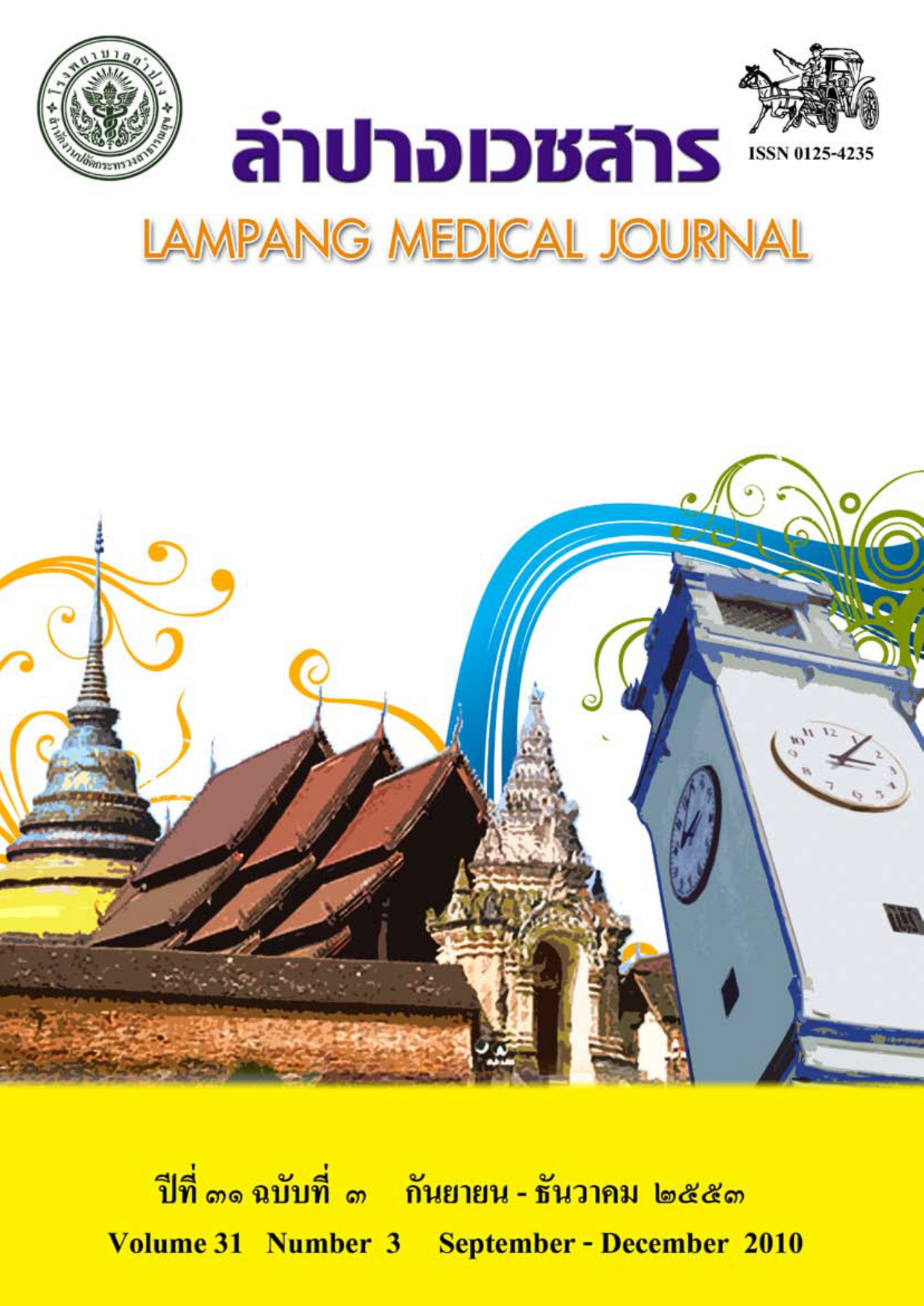Chloroquine Maculopathy in Chiang Rai Regional Hospital
Main Article Content
Abstract
Background: Maculopathy is the most serious ophthalmic adverse event of chloroquine and causes permanent visual loss. Many previous studies showed the association between chloroquine maculopathy and several risk factors, but the conclusion was unclear.
Objective: To study the incidence and risk factors of chloroquine maculopathy in Chiang Rai Regional Hospital.
Material and method: An analytic cross-sectional study was conducted on 51 out-patients who received chloroquine for their treatment and had eye examination in Chiang Rai Regional Hospital during 1st January – 31st December 2009. The data was retrospectively collected; including age, gender, cumulative dose, duration of treatment and examination results. The data was analyzed by descriptive statistics, t- test and Mann-Whitney U test.
Results: Most of the patients were female (88.2%). The mean age was 49.6 ± 13.7 years (range, 14-83). The mean duration of treatment was 48.8 ± 36.4 months (range, 7-168). The mean cumulative dose was 336.9 ± 226 grams (range, 53-1260). All of the patients had fundoscopic examination under slit lamp and +78 D lens. Color test was performed in 35 patients whereas
only half had visual field examination. Cornea verticilata was found in 7 patients. Sixteen patients (31.4%) were diagnosed as chloroquine maculopathy. There was no statistical difference in age, cumulative dose and duration of treatment between normal group and maculopathy group (p=0.47, 0.19 and 0.22 respectively).
Conclusion: Chloroquine maculopathy was not associated with age, cumulative dose and duration
of treatment
Article Details

This work is licensed under a Creative Commons Attribution-NonCommercial-NoDerivatives 4.0 International License.
บทความที่ส่งมาลงพิมพ์ต้องไม่เคยพิมพ์หรือกำลังได้รับการพิจารณาตีพิมพ์ในวารสารอื่น เนื้อหาในบทความต้องเป็นผลงานของผู้นิพนธ์เอง ไม่ได้ลอกเลียนหรือตัดทอนจากบทความอื่น โดยไม่ได้รับอนุญาตหรือไม่ได้อ้างอิงอย่างเหมาะสม การแก้ไขหรือให้ข้อมูลเพิ่มเติมแก่กองบรรณาธิการ จะต้องเสร็จสิ้นเป็นที่เรียบร้อยก่อนจะได้รับพิจารณาตีพิมพ์ และบทความที่ตีพิมพ์แล้วเป็นสมบัติ ของลำปางเวชสาร
References
Isaacson D, Elgart M, Turner ML. Antimararials in dermatology. Int J Dermatol 1982; 21:379-95.
Koranda FC. Antimalarials. J Am Acad Dermatol 1981; 4:650-5.
Puavilai S, Kunavisarut S, Vatanasuk M, Timpatanapong P, Sriwong S, Janvitayanujit S, et al. Ocular toxicity of chloroquine among Thai patients. Int J Dematol 1999; 38:934-7.
Michael FM, Ronald EC, Michael E, Ayad AF, William FM. Recommendations on screening for chloroquine and hydroxychloroquine retinopathy. Ophthalmol 2002: 109(7):1377-82.
Leecharoen S, Wangkaew S, Louthrenoo W. Ocular side effects of chloroquine in patients with rheumatoid arthritis, systemic lupus erythematosus and scleroderma. J Med Assoc Thai 2007; 90(1):52-8.
Samuel KS, Maia J, Tizziani CM, Morita C, Kochen J, Takahashi W, et al. Chloroquine induced bull’s eye maculoapathy in rheumatoid arthritis: related to disease duration?. Clin Rheumatol 2007; 26:1248-53.


